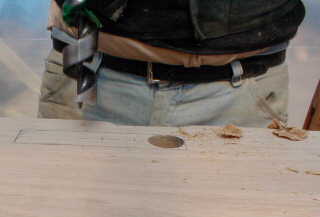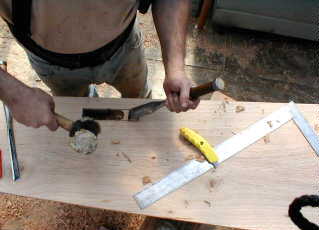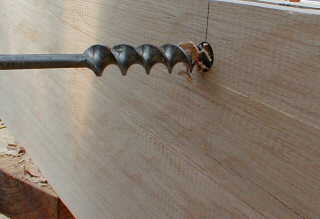
Guide to building a timber frame home
Copyright 2008 by Kevin Shea, Tracie Shea, Morris Rosenthal
- Roughing a Post
- Cutting a Mortise
- Mortise and Tenon
- Peg Making
- Steam Box Design
- Steam Bending
- Arch Brace Lamination
- Scribing a King Post
- Fitting an Arch Brace
- Copper Roofing
Copyright 2008 by Morris Rosenthal
All Rights Reserved
Cutting a Mortise in a Post

|
The first step in cutting a mortise is to lay it out. As all woodworkers are fond of saying, "Measure twice, cut once." One of the key measurements for a mortise is the depth, though it can't be marked out in the timber. Once the location of the mortise is established and outlined in pencil, the trick becomes getting the wood out of there. The quickest way, without resort to special mortising tools, is by drilling a series of holes to the proper depth before resorting to the chisel. It's as good a time as any to mention that the hand forged chisels favored by timber framers may run a little small, so that our 2" chisel is really 1-7/8" wide, and can't be used to dimension the mortise. |
| Since the brace intersects the post and beam at an angle, the mortise should be angled to receive it. If you don't angle the mortise, nobody will know (assuming you get the face dimension correct), but there will be a small hollow space inside the beam. Again, since there's no way to mark out the angle inside the uncut mortise, Kevin just tries to angle the chisel properly as he cuts out the wood, and frequently tests the mortise with the tenon of a test brace. The standard depth for a mortise is 3", and the standard width for a tenon is 2". |

|

|
You can see just how green and stringy the White Oak really is as the chisel cuts in the angle. Sharp chisels are crucial on any job, but particularly so with the dense hardwoods. Don't try to sharpen your chisels on high speed grinding wheels or they'll heat up and loose their temper. Once the temper is gone, you can do the best sharpening job in the world and it will be dull again in no time. Either sharpen your chisels by hand on a whetstone, or use a very slow wheel, constantly dripping water on the contact area to keep the temperature down. |
| Once the mortise is cut out, the final step is to drill the peg hole. The ideal tool for this is a ship's auger, because the fine twist will continually remove the wood from the hole as the auger bores in. Augers work at low rotational speeds, and are usually used in hand drills, as this one is (trust me, just cropped it out of the picture). Other types of drills, regular twist drills and hole saws won't be able to expel the large White Oak chips quickly enough at depth, and some may mess up the surface of the beam. If anybody knows where I can get a good deal on a 2" ship's auger, please drop me a line. |

|